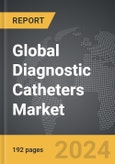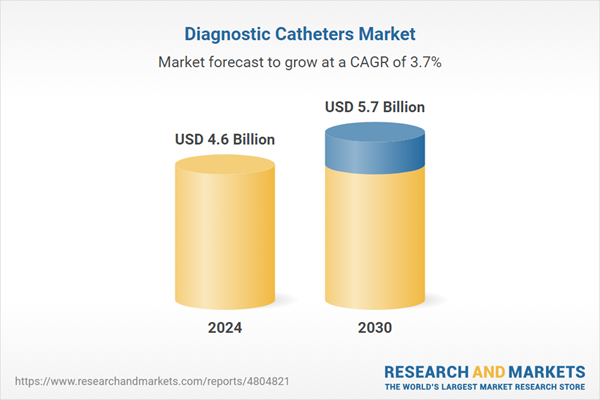The global market for Diagnostic Catheters was valued at US$4.6 Billion in 2024 and is projected to reach US$5.7 Billion by 2030, growing at a CAGR of 3.7% from 2024 to 2030. This comprehensive report provides an in-depth analysis of market trends, drivers, and forecasts, helping you make informed business decisions. The report includes the most recent global tariff developments and how they impact the Diagnostic Catheters market.
Segments: Segment (Diagnostic, Non-Imaging); Type (Angiography Catheters, Ultrasound Catheters, OCT Catheters, Electrophysiology (EP) Catheters, Other Types); End-User (Imaging & Diagnostic Centers, Hospitals).
Geographic Regions/Countries: World; United States; Canada; Japan; China; Europe (France; Germany; Italy; United Kingdom; Spain; Russia; and Rest of Europe); Asia-Pacific (Australia; India; South Korea; and Rest of Asia-Pacific); Latin America (Argentina; Brazil; Mexico; and Rest of Latin America); Middle East (Iran; Israel; Saudi Arabia; United Arab Emirates; and Rest of Middle East); and Africa.
The analysts continuously track trade developments worldwide, drawing insights from leading global economists and over 200 industry and policy institutions, including think tanks, trade organizations, and national economic advisory bodies. This intelligence is integrated into forecasting models to provide timely, data-driven analysis of emerging risks and opportunities.
Global Diagnostic Catheters Market - Key Trends and Drivers Summarized
What Are Diagnostic Catheters and How Do They Transform Medical Procedures?
Diagnostic catheters are specialized medical devices used extensively in cardiology, urology, and neurology to diagnose various conditions within the body’s internal organs. These flexible tubes are designed to navigate the vascular system, allowing physicians to conduct detailed internal examinations, perform biopsies, and measure physiological parameters such as blood pressure and oxygen saturation within blood vessels. In cardiology, diagnostic catheters are critical for performing angiography and intravascular ultrasound, providing detailed images of the heart and blood vessels that aid in the diagnosis of conditions like coronary artery disease. Their importance is underscored by their precision and the minimal invasiveness compared to traditional surgical approaches, which significantly reduces patient recovery times and improves the safety of diagnostic procedures.How Have Technological Advancements Improved Diagnostic Catheters?
Recent technological advancements have significantly enhanced the functionality and safety of diagnostic catheters. Modern catheters are equipped with high-definition imaging capabilities, such as optical coherence tomography (OCT) and fractional flow reserve (FFR), which offer high-resolution images and precise measurements of blood flow and arterial blockages. These features allow for more accurate diagnoses and tailored treatments. Additionally, the integration of digital technology facilitates real-time data transmission to monitoring systems, enabling immediate analysis and decision-making during diagnostic procedures. The materials used in manufacturing these catheters have also evolved, with the latest designs featuring biocompatible and flexible materials that reduce the risk of vessel trauma and improve patient comfort during procedures.What Role Does Diagnostic Catheterization Play in Modern Healthcare?
Diagnostic catheterization holds a pivotal role in modern healthcare by enabling early detection and diagnosis of critical conditions, which can be life-saving. In the realm of cardiology, catheters are used not only for diagnosis but also for guiding interventions such as stent placements and balloon angioplasties. In neurology, they are essential for assessing vascular conditions in the brain, such as aneurysms and vessel stenoses, which are critical for planning surgical or endovascular treatments. The ability to perform these assessments quickly and accurately directly impacts patient outcomes by facilitating timely and appropriate treatment interventions. Moreover, the use of diagnostic catheters in urology helps in evaluating urinary tract abnormalities, providing essential information for the treatment of kidney stones or tumors without the need for invasive surgery.What Drives the Growing Market for Diagnostic Catheters?
The growth in the diagnostic catheters market is driven by several factors, including the rising prevalence of cardiovascular diseases, technological advancements in catheter technology, and an increasing preference for minimally invasive diagnostic procedures. As global populations age, the incidence of chronic diseases that require diagnostic interventions, such as heart disease and stroke, continues to rise, creating a steady demand for catheter-based diagnostic solutions. Technological innovations that offer enhanced imaging, greater procedural safety, and improved patient comfort are making these devices more appealing to healthcare providers. Furthermore, the shift towards personalized medicine and the demand for precise diagnostic tools in clinical settings contribute to the expansion of this market. Economic development in emerging regions and increased healthcare spending also facilitate wider access to advanced diagnostic modalities, further propelling the market growth of diagnostic catheters. These factors, combined with ongoing medical education and training in minimally invasive techniques, ensure a dynamic and expanding market for these essential medical devices.Report Scope
The report analyzes the Diagnostic Catheters market, presented in terms of units. The analysis covers the key segments and geographic regions outlined below.Segments: Segment (Diagnostic, Non-Imaging); Type (Angiography Catheters, Ultrasound Catheters, OCT Catheters, Electrophysiology (EP) Catheters, Other Types); End-User (Imaging & Diagnostic Centers, Hospitals).
Geographic Regions/Countries: World; United States; Canada; Japan; China; Europe (France; Germany; Italy; United Kingdom; Spain; Russia; and Rest of Europe); Asia-Pacific (Australia; India; South Korea; and Rest of Asia-Pacific); Latin America (Argentina; Brazil; Mexico; and Rest of Latin America); Middle East (Iran; Israel; Saudi Arabia; United Arab Emirates; and Rest of Middle East); and Africa.
Key Insights:
- Market Growth: Understand the significant growth trajectory of the Diagnostic Catheters segment, which is expected to reach US$3.8 Billion by 2030 with a CAGR of a 4.5%. The Non-Imaging Catheters segment is also set to grow at 2.2% CAGR over the analysis period.
- Regional Analysis: Gain insights into the U.S. market, valued at $1.2 Billion in 2024, and China, forecasted to grow at an impressive 6.6% CAGR to reach $1.2 Billion by 2030. Discover growth trends in other key regions, including Japan, Canada, Germany, and the Asia-Pacific.
Why You Should Buy This Report:
- Detailed Market Analysis: Access a thorough analysis of the Global Diagnostic Catheters Market, covering all major geographic regions and market segments.
- Competitive Insights: Get an overview of the competitive landscape, including the market presence of major players across different geographies.
- Future Trends and Drivers: Understand the key trends and drivers shaping the future of the Global Diagnostic Catheters Market.
- Actionable Insights: Benefit from actionable insights that can help you identify new revenue opportunities and make strategic business decisions.
Key Questions Answered:
- How is the Global Diagnostic Catheters Market expected to evolve by 2030?
- What are the main drivers and restraints affecting the market?
- Which market segments will grow the most over the forecast period?
- How will market shares for different regions and segments change by 2030?
- Who are the leading players in the market, and what are their prospects?
Report Features:
- Comprehensive Market Data: Independent analysis of annual sales and market forecasts in US$ Million from 2024 to 2030.
- In-Depth Regional Analysis: Detailed insights into key markets, including the U.S., China, Japan, Canada, Europe, Asia-Pacific, Latin America, Middle East, and Africa.
- Company Profiles: Coverage of players such as B. Braun Melsungen AG, BARD, A Becton, Dickinson Company, Boston Scientific Corporation, Cardinal Health, Inc., Edwards Lifesciences Corporation and more.
- Complimentary Updates: Receive free report updates for one year to keep you informed of the latest market developments.
Some of the 38 companies featured in this Diagnostic Catheters market report include:
- B. Braun Melsungen AG
- BARD, A Becton, Dickinson Company
- Boston Scientific Corporation
- Cardinal Health, Inc.
- Edwards Lifesciences Corporation
- Johnson & Johnson
- Koninklijke Philips NV
- Medtronic PLC
- St. Jude Medical, Inc.
- Terumo Corporation
Tariff Impact Analysis: Key Insights for 2025
Global tariff negotiations across 180+ countries are reshaping supply chains, costs, and competitiveness. This report reflects the latest developments as of April 2025 and incorporates forward-looking insights into the market outlook.The analysts continuously track trade developments worldwide, drawing insights from leading global economists and over 200 industry and policy institutions, including think tanks, trade organizations, and national economic advisory bodies. This intelligence is integrated into forecasting models to provide timely, data-driven analysis of emerging risks and opportunities.
What’s Included in This Edition:
- Tariff-adjusted market forecasts by region and segment
- Analysis of cost and supply chain implications by sourcing and trade exposure
- Strategic insights into geographic shifts
Buyers receive a free July 2025 update with:
- Finalized tariff impacts and new trade agreement effects
- Updated projections reflecting global sourcing and cost shifts
- Expanded country-specific coverage across the industry
Table of Contents
I. METHODOLOGYII. EXECUTIVE SUMMARY2. FOCUS ON SELECT PLAYERSIII. MARKET ANALYSISCANADAITALYSPAINRUSSIAREST OF EUROPESOUTH KOREAREST OF ASIA-PACIFICARGENTINABRAZILMEXICOREST OF LATIN AMERICAIRANISRAELSAUDI ARABIAUNITED ARAB EMIRATESREST OF MIDDLE EASTIV. COMPETITION
1. MARKET OVERVIEW
3. MARKET TRENDS & DRIVERS
4. GLOBAL MARKET PERSPECTIVE
UNITED STATES
JAPAN
CHINA
EUROPE
FRANCE
GERMANY
UNITED KINGDOM
ASIA-PACIFIC
AUSTRALIA
INDIA
LATIN AMERICA
MIDDLE EAST
AFRICA
Companies Mentioned (Partial List)
A selection of companies mentioned in this report includes, but is not limited to:
- B. Braun Melsungen AG
- BARD, A Becton, Dickinson Company
- Boston Scientific Corporation
- Cardinal Health, Inc.
- Edwards Lifesciences Corporation
- Johnson & Johnson
- Koninklijke Philips NV
- Medtronic PLC
- St. Jude Medical, Inc.
- Terumo Corporation
Table Information
| Report Attribute | Details |
|---|---|
| No. of Pages | 192 |
| Published | April 2025 |
| Forecast Period | 2024 - 2030 |
| Estimated Market Value ( USD | $ 4.6 Billion |
| Forecasted Market Value ( USD | $ 5.7 Billion |
| Compound Annual Growth Rate | 3.7% |
| Regions Covered | Global |









